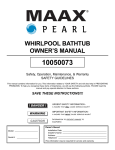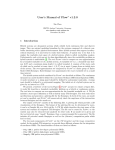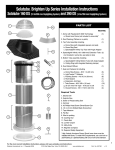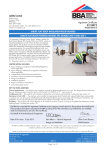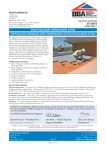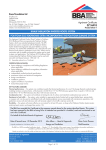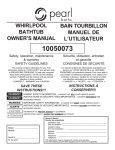Download ICO2366 HOT MELT INSTALLATION MANUAL - Version 3
Transcript
Parabit Installation Manual Hot Melt Waterproofing Membrane Installation Manual Prepared by Icopal Limited Version 3 ICO2366 Contents PART 1 - General 1.1 1.2 1.3 1.4 1.5 1.6 1.7 1.8 1.9 1.10 1.11 System Description Typical Roof Design Applications Third Party References Quality Assurances Storage, Handling, Delivery Project Conditions Unique Characteristics Tools & Equipment Density of Concrete Substrate Other substrates Roof Drainage PART 2 - Parabit Product Range 2.1 2.2 Hot Applied Liquid Membrane Accessories PART 3 - Execution 3.1 3.2 3.3 3.4 3.5 3.6 3.7 3.8 Inspection Surface Preparation Application Protection Course Electronic Surface Fault Detection Test Repairs Overnight Insulation PART 4 4.1 4.2 4.3 4.4 4.5 Roof Coverings Inverted Roofs Plaza Decks Green Roofs Substructures Access Roadways Part 1 - General 1.5 The advice offered in the following document should be followed in complete compliance with all health and safety requirements associated with the materials use. 1.1 Delivery, Storage and Handling a) Deliver materials to project site in original, factory-sealed, unopened containers bearing manufacturer’s name and label intact and legible with following information. 1. Name of material 2. Manufacturer’s stock number and date of manufacture 3. Material safety data sheet b) Store flashing and primer in a protected area out of direct sunlight. Protect from rain and physical damage. System Description A hot applied rubberised bitumen membrane system, consisting of two layers of rubberised bitumen, reinforced with a polyester fabric and protected with a compatible bitumen membrane. 1.2 Typical Roof Design Applications 1.6 Parabit is ideally suited where one of the following roof designs are intended: a) b) c) d) e) 1.3 b) c) d) 1.4 a) Inverted Roofs (Ballasted / Paved) Plaza Decks or Podiums Green Roofs (Extensive & Intensive) Access Roadways Sub-structures (Tanking) Third Party References a) Project Conditions CGSB-37.50-M89 Canadian Specification for Hot Applied, rubberised bitumen for roofing and waterproofing. ASTM applicable standards and test methods. UL 790 Tests for fire resistance of roof materials. BBA Certified (08/4514) b) c) d) Quality Assurance a) b) c) Applicator Qualifications: Applicator shall be experienced in applying the same or similar materials and shall be specifically approved in writing by the membrane manufacturer. Regulatory requirements: Comply with applicable codes, regulations, ordinances and laws regarding use and application of products that contain volatile organic compounds (VOC’s). Pre-application conference: Prior to beginning work, convene a conference to review conditions, installation procedures, schedules and co-ordination with other work. e) f) Do not apply membrane if temperature is less than 0º F (-18ºC) or to a damp, frosty, snow covered or contaminated surface. Should rain interrupt application, allow one full day of good drying conditions before continuing with the system installation. Any surface dampness can seriously affect adhesion of the membrane system. Co-ordinate waterproofing work with other trades. The applicator shall have sole right of access to the specified areas for the time needed to complete the application. Protect adjoining surfaces not to be waterproofed against damage or spoiling. Protect plants, vegetation and animals which might be affected by waterproofing operations. Warn personnel against breathing of vapours and contact of material with skin or eyes. Wear applicable protective clothing and respiratory protection gear. Refer to relevant material safety data sheet. Keep flammable products away from spark or flame. Do not allow the use of spark producing equipment during application until all vapours have dissipated. Post, ‘NO SMOKING’ signs. Maintain work area in a neat and orderly condition, removing empty containers, rags and rubbish daily from the site. 1.7 Unique Characteristics a) b) c) d) 1.8 Part 2 – Parabit Product Range Tools & Equipment 2.1 Mixer – Twin walled mixer (air or oil jacketed) with continuous mechanical agitation. b) Brushes, squeegees (rubber edged), shovels, rollers. c) Buckets, transfer pails (with nozzle). d) Scissors, Stanley Knives e) Depth gauge (tyre tread depth gauge) f) Personal Protection Equipment (See material safety data sheet) g) Hand squeegee, trowel Note: All tools should be cleaned daily. a) b) c) d) e) f) Consult Icopal’s Technical Dept for preparation advice. Self-Healing: Minor damage will self heal whilst the membrane is clean, dry & warm Laps: When lapping with existing material, the heat of freshly installed Parabit CCW-500 will re-activate the existing product fusing the two together maintaining a monolithic membrane. This feature allows installation of the Parabit system to be phased in sequence with other construction programmes. Low Temperature Flexibility: The Parabit system can be applied in temperatures as low as -18ºC. Solvent Free: The Parabit membrane is a single component product. a) 1.9 1.10 Other Substrates a) Plywood b) OSB c) Metal Deck Density of Concrete Substrate In-situ: Structural concrete will have a density of 2,160kg/m³ - 2,500kg/m³ and will retain 3 – 5% moisture by volume when cured. Concrete with high moisture content requires a minimum curing period of 28 days to ensure adequate drying. Low density concrete (less than 1,850kg/m³) will create adhesion difficulties due to the friable / dusty nature of the surface. Precast Concrete: This is generally an ideal substrate for the Parabit system. Concrete block: For vertical applications, concrete block is acceptable. In situ concrete surfaces should be finished with a wood float or fine broom. Steel trowel or power floated surfaces are not desirable. Lightweight Insulating Concretes are not acceptable substrates Lightweight Structural Concretesa are considered acceptable substrates where the density is between 1400 kg/m³ - 1800 kg/m³, retaining 5 – 20% moisture by volume when cured. 1.11 Roof Drainage It is the considered opinion of the manufacturer that zero falls are acceptable where the scheme is inverted or fully protected with slabs / ballast and where 3rd party accreditation accompanies the system. Hot Applied Liquid Membrane Liquid Membrane: Parabit Hot Applied Membrane comprising rubberised bitumen compound formulated from a combination of bitumen, oils and synthetic rubbers. Supplied in individual cardboard boxes weighing approximately 14kg, Reinforcing Fabric: Parabit CCW-500 Reinforcing Fabric is a spunbonded polyester fabric. 2.2 Accessory Products Flashings: Shall be Parabit CCW-711 or Parabit CCW Uncured Neoprene Flashing. Surface Primer: Shall be Parabit CCW-550 Primer. A solvent based bituminous primer specifically designed for concrete surfaces. Icopal to be advised prior to application. Backer Rod: Shall be closed-cell polyethylene foam rod Expansion Joints: Shall be Parabit CCW-711 or Parabit CCW Uncured Neoprene. Where expansion joints are exposed refer to Icopal’s technical department. Protection Parabit Protection Layers include Layers: Anderson 3B, Power Elastomeric 180 Sanded, Power Elastomeric 250 Sanded, Rootbar Capsheet or XtraSeal Protection Board Drainage Board: Shall be Fytonop 12 Bond Testing Insulation: Shall be Thermazone Hydroshield EPS Insulation Board. Before the Parabit system is installed a bond test must be conducted to ascertain the suitability of the concrete surface. Bond tests to the area to be coated that day are advised prior to the main application. Part 3 - Execution 3.1 Inspection Before any waterproofing work is started the waterproofing applicator shall thoroughly examine all surfaces for any deficiences. Should any deficiences exist , the architect, owner or general contractor shall be notified in writing and corrections made. Condition of Concrete Surfaces The concrete surfaces shall be of sound structural grade, 3500 psi minimum and shall have a wood float or fine broom finish, free of fins, ridges, voids or entrained air holes. A steel trowelled finish or shiny surface is not acceptable. All knots and dust must be removed Laitance: Loose concrete towards the surface of the concrete must be removed. Concrete shall be cured by water curing method. Pure sodium silicate curing compounds are acceptable. Contamination: All contaminants must be properly cleaned before application of the Parabit system can commence. Concrete shall be cured for a min. 14 days / max. 21 days. Refer to section 1.9 for further details. Voids, rock pockets and excessively rough surfaces shall be repaired with approved non-shrink grout or ground to match the un-repaired areas. Two-stage drains shall have a minimum 75mm flange and be installed with the flange flush and level with the concrete surface. Form Release Agents used to facilitate removal of formwork from cast concrete can be transferred to the face of the concrete once the formwork has been struck. Such agents can detrimentally affect the adhesion of the monolithic membrane. As a result all agents transferred to concrete must be removed prior to application of the membrane. Furthermore, accelerators within the concrete can migrate to the surface leaving a shiny surface. These should be removed. To complete the bond test, apply a small amount of primer to the cleaned and prepared area and allow to dry. Apply a small amount of the Parabit membrane and allow it to cool. Make a triangular incision into the middle of the patch. If the membrane can be easily peeled away from the deck then substrate is not ready. If it is not possible to peel back the membrane, the adhesion is considered satisfactory. If the test patch is acceptable, protect the patch until the main area material is to be applied. The test material will re-act with the new material maintaining a monolithic membrane. 3.2 Surface Preparation / Details The concrete surface must be thoroughly clean, dry and free from any surface contaminates (laitance) or cleaning residue that may harmfully affect the adhesion of the membrane. The concrete shall be structurally sound. Correct preparation of the surface is essential. Detail expansion recommendation. joints as per manufacturer’s Cracks: Prepare the crack by grinding back the edges – never feather the edges. Apply a thin film of Parabit CCW-550 Primer 400mm wide, centred over sealed crack / joint. Apply 1.5 – 2.3mm of Parabit membrane to cover primed areas. Install a 300mm strip of Parabit CCW-711-90 or Parabit Uncured Neoprene flashing centred over joints and cracks. Preferred Upstand Method: All detail work is typically completed before the main field area application. Apply Parabit CCW-550 Primer at the juncture of all horizontal and vertical surfaces to the height indicated at a rate of 10 – 15 square metres per litre. Avoid puddles. Allow primer to dry 1 hour minimum, 8 hours maximum or when dry to touch. If primed surface is left longer than 8 hours, the surface shall be re-primed with a light coating of the Parabit CCW-550 primer. Membrane will not properly adhere to wet primer Trowel Method: Using a wood or hardboard hand trowel / spreader, Parabit hot melt is poured in to a trough from which it is brought up the vertical surface using the spreader. Typically the membrane can be brought up to shoulder height using this method. Apply 1.5 – 2.3mm of Parabit hot melt to cover primed areas. Install Parabit CCW-711-90 or Parabit Uncured Neoprene flashing into the hot melt extending up the vertical surface and onto the horizontal surface approximately 150mm. Completely cover all flashing material during installation of subsequent layers of Parabit membrane, including the Parabit Reinforcing Fleece and protection layer. Around drains apply a thin film of Parabit CCW-550 Primer in a 0.37 square meter area. Allow primer to dry, 1 hour minimum, 8 hours maximum. Apply 1.5 – 2.3mm of Parabit CCW-500 membrane to cover primed areas. Install 0.3 square metre section of Parabit CCW-711-90 or Parabit Uncured Neoprene Flashing over the drain and onto the deck. No splices or seams are allowed within 75mm of the drain flange. Terminate the flashing under the clamping ring of the drain and cut away the inner portion of the flashing. Use firm pressure to press the flashing against the Parabit membrane and ensure good adhesion. Do not interfere with weep holes. 3.3 Application – Main Area Apply Parabit CCW-550 Primer to all surfaces and at the juncture of all horizontal and vertical surfaces. Avoid puddles. Allow primer to dry for 1 hour minimum, 8 hours maximum or when dry to touch. If primed surface is left longer than 8 hours, the surface shall be re-primed with a light coating of the Parabit CCW-550 primer. Membrane will not properly adhere to wet primer. The primer is best applied by roller. Primer should be brown / scatter primed. Heat Parabit hot melt membrane blocks in a twin wall (air or oil jacketed) kettle with continuous agitation and apply at temperatures between 190ºC to 202ºC. (Caution: Do not exceed maximum safe operating temperature of 204ºC). The mixer should be thermostatically controlled. Apply heated Parabit Hot Applied Membrane to primed area at a rate of 0.44 square metres per litre or as required to obtain an average first layer thickness of 2.3mm. Work Method of Application (Grid Method): consistently in one direction in strips approximately 1m wide. Pour the hot rubber membrane in a line along the top / bottom edge of the strip. With very little downward pressure and using a rubber edged, long handled squeegee, pull approximately two thirds of the liquid towards you. Continue this process down the strip. Returning to the beginning push the remaining liquid. Again continue working in the one direction. Finally, return to the beginning for a third time and pull all remaining liquid across the surface. Check the depth using a thickness gauge. Repeat with additional passes if required. Apply Parabit CCW-500 Reinforcing Fabric while membrane is still warm and tacky. Cut and trim off any wrinkles or overlap sections of the reinforcing fabric. Brush the fabric into the membrane as it is rolled out. Overlap the reinforcing fabric onto the adjoining layer a minimum 50mm ensuring the liquid hot melt overlaps 75 mm so that overlapping fabrics are sealed. Apply a second coat of Parabit Hot Applied Membrane at a rate of 0.3 square metres per litre or as required to obtain an average thickness of 3.2mm. Total thickness of the Parabit System shall be 5.5mm or 6.4kg per square metre. Apply the appropriate protection layer into the final course of Parabit hot melt membrane and scrape / splice the protection layer seams together with hot melt. The choice of protection layer will depend upon the intended use of the roof. Where the protection layer is exposed a mineral surfaced membrane shall be used. For green roof or tanking applications Icopal Rootbar Capsheet shall be used as the protection layer. The laps must be torch sealed (rather than sealed with a scraper) to inhibit root penetration. 3.4 Protection Course Where rapid removal of rainwater is desired, install Fytonop 12 Drainage Board over the protection layer immediately after the leak detection test on horizontal surfaces. If testing is delayed, install a temporary covering to protect the Parabit membrane from damage by other trades. 3.5 Electronic Surface Fault Detection Test Upon completion of the waterproofing works, the integrity of the membrane must be electronically tested before any ballast, insulation or other items are placed above the membrane. The electonic detector shall confirm the presence of any punctures / defects which may be repaired prior to covering and subsequently re-tested. Before any warranty is issued a leak test certificate must be provided. Alternatively, prior to the installation of the subsequent topping layers, the area of horizontal membrane can be water tested with 50mm water over a 48 hour period. Any leaks detected shall be repaired and the area re-tested. 3.6 Repairs Should the completed Parabit membrane be damaged during construction repairs can be made by carefully removing the protection layer in a 300mm diameter beyond the damaged section. Clean the existing, damaged membrane prior to applying new, hot membrane. The heat from the new membrane will fuse with the existing, forming a monolithic repair. 3.7 Overnight At the end of the working day all areas should be completely sealed / waterproofed, particularly the reinforcing fabric. 3.8 Insulation Place Thermazone Hydroshield EPS insulation board incorporating Monarperm 700 water reducing layer above the completed hot melt membrane. Boards should staggered and laps of the membrane should be taped. Part 4 - Roof Coverings 4.1 Inverted Roof Coverings Typically, inverted roofs require an extruded polystyrene insulation board to be installed above the waterproofing layer followed by a filter fleece prior to being covered with ballast or paving slabs. All insulation boards should be laid staggered and butt jointed. Filter fleece to be loose laid above the insulation layer with all overlaps to be 300mm minimum. Ballast to be river washed stone or gravel ballast. 4.2 Plaza decks Following completion of the waterproofing and installation of the drainage layer, the surface shall receive pavings in accordance with BS 7263: Pt.1 laid on an appropriate bed by others. 4.3 Green Roofs Icopal Extensive or Intensive Green Roof build-ups can be installed above the completed waterproofing layer. For further assistance refer to the Icopal Green Roof Brochure or contact Icopal’s technical department. 4.4 Substructures (Tanking) Below ground applications of the Parabit system shall be protected using the Rootbar Capsheet Protection Layer. Install Fytonop 12 Drainage Board as backfilling progresses to further protect the waterproofing tanking system whilst also facilitating removal of groundwater to the dedicated drainage system. 4.5 Access Roadways Parabit PL 3 Protection Layer shall be used to provide greater durability prior to the application of the finished roadway wearing course by others.









